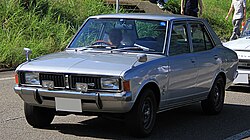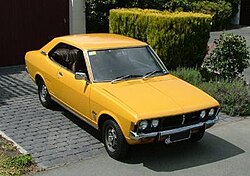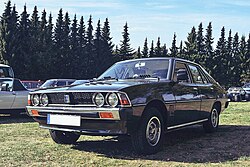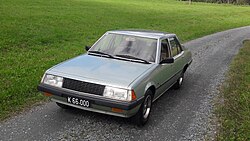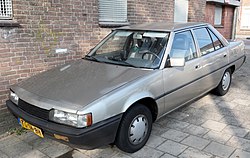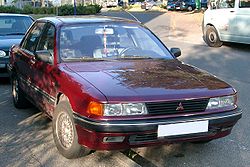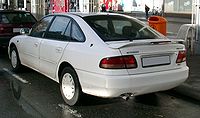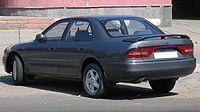Mitsubishi Galant
| Mitsubishi Galant | |
|---|---|
| Production period: | 1969-2012 |
| Class : | Middle class |
| Body versions : | Sedan , hatchback , station wagon , coupe |
The Mitsubishi Galant is a 1969-2012 built and the middle class associated with passenger cars of the Japanese manufacturer Mitsubishi . The Galant was also offered in Germany until autumn 2004.
Galant (A2GS, 1969–1973)
| 1st generation | |
|---|---|
|
Mitsubishi Colt Galant (1969-1973) |
|
| Production period: | 1969-1973 |
| Body versions : | Sedan , station wagon , coupé |
| Engines: |
Petrol engines : 1.3-1.6 liters (64-74 kW) |
| Length: | 4060 mm |
| Width: | 1560 mm |
| Height: | 1385 mm |
| Wheelbase : | |
| Empty weight : | 825 kg |
The first generation Mitsubishi Galant, initially marketed as the Colt Galant , was introduced in December 1969.
Initially, there was only a four-door sedan with a 1.3- or 1.5-liter four-cylinder in three versions. In the spring of 1970, a two-door notchback coupé followed , which was the first Japanese car to dispense with B-pillars (so-called hardtop coupé). The Colt Galant was the first Mitsubishi model to be exported to North America, where it was sold under the name Dodge Colt after the Chrysler group took over shares in Mitsubishi in 1970/71. A five-door station wagon was also available from mid-1970 .
Also in 1970 Mitsubishi had the other models followed by a hatchback coupé called the Galant GTO , which was stylistically based on the American muscle cars , was available with three different engines and remained on offer until 1975. The model name GTO was revived by Mitsubishi with the Mitsubishi GTO in the 1990s.
In spring 1971, another coupé variant called the Galant FTO with a 1.4-liter four-cylinder came into the range. This designation was also resumed by the factory in the 1990s with the Mitsubishi FTO .
This type attracted attention through rally successes in 1972 and 1973 (Southern Cross Rallye).
The first Galant was not offered in Germany.
| Technical data Mitsubishi Colt Galant, 1973 models | ||||
| Mitsubishi Colt Galant: | 1.4 | 1.6 | GTO 1.7 | GTO 1.6 |
|---|---|---|---|---|
| Engine: | 4-cylinder in-line engine (four-stroke) | |||
| Displacement: | 1439 cc | 1597 cc | 1686 cc | 1593 cc |
| Bore × stroke: | 73 × 86 mm | 76.9 × 86 mm | 79 × 86 mm | 76.9 × 86 mm |
| Performance at 1 / min: | 68 kW (92 SAE PS) at 6300 |
74–81 kW (100–110 SAE hp) at 6300-6700 |
77–85 kW (105–115 SAE hp) at 6300 |
92 kW (125 SAE PS) at 6800 |
| Max. Torque at 1 / min: | 122 SAE-Nm at 4000 | 137-139 SAE-Nm at 4000-4800 | 147-149 SAE-Nm at 4000-4500 | 142 Nm at 5000 |
| Compression: | 9.0: 1 | 8.5-9.5: 1 | 9.5: 1 | |
| Mixture preparation: | 1 downdraft carburetor | 1 downdraft or 2 SU carburettors | 2 SU horizontal carburetors | |
| Valve control: | OHC , chain | DOHC , chain | ||
| Cooling: | Water cooling | |||
| Transmission: | 3- or 4-speed gearbox aW 3-speed automatic rear-wheel drive |
4-speed transmission aW 3-speed automatic rear-wheel drive |
5-speed rear-wheel drive transmission |
|
| Front suspension: | Wishbones, tension struts, coil springs | |||
| Rear suspension: | Rigid axle, semi-elliptical leaf springs | |||
| Brakes: | Drum brakes all around aW front disc brakes (diameter 23.9 cm) |
Disc brakes at the front (diameter 23.9 cm), drum brakes at the rear | ||
| Steering: | Worm steering | |||
| Body: | Sheet steel, self-supporting | |||
| Track width front / rear: | 1285/1285 mm | |||
| Wheelbase: | 2420 mm | |||
| Dimensions: | 4080 × 1560 × 1360 mm | 4125 × 1580 × 1325 mm | ||
| Empty weight: | 880-930 kg | 925-970 kg | 980 kg | |
| Top speed: | 160 km / h | 165-175 km / h | 175-185 km / h | 200 km / h |
| 0-100 km / h: | not specified | |||
| Consumption (liters / 100 kilometers): | 8-12 pp | 9-14 p | 9-14 p | 10-15 p |
Galant (A112 / A114 / A115, 1973-1976)
| 2nd generation | |
|---|---|
|
Mitsubishi Galant (1973-1976) |
|
| Production period: | 1973-1976 |
| Body versions : | Sedan , station wagon , coupé |
| Engines: |
Otto engines : 1.6–2.0 liters (74–92 kW) |
| Length: | 4200 mm |
| Width: | 1600 mm |
| Height: | 1395 mm |
| Wheelbase : | 2420 mm |
| Empty weight : | 900-920 kg |
The second generation Galant was exported on a larger scale; in North America it was again offered as Dodge Colt , in Australia as Chrysler Valiant Galant and in some European markets (but not in Germany) as Colt Galant.
The hallmarks of this series were the more rounded body shape with fashionable hips and the use of a new generation of engines from the Astron family to complement the machines from the Saturn series that were previously used . These developed up to 125 hp and, in some versions, were the first to come up with the Silent Shaft balancer shafts patented by Mitsubishi to increase the smoothness of the engine.
Galant (A120, 1976-1980)
| 3rd generation | |
|---|---|
|
Mitsubishi Galant (1976-1980) |
|
| Production period: | 1976-1980 |
| Body versions : | Limousine , station wagon |
| Engines: |
Petrol engines : 1.6–2.0 liters (55–63 kW) |
| Length: | 4330 mm |
| Width: | 1665 mm |
| Height: | 1360 mm |
| Wheelbase : | |
| Empty weight : | 1070 kg |
The third Galant, introduced in mid-1976 and called Galant Σ (Sigma) in Japan, was also offered in Germany under the name Mitsubishi Galant from February 1977 after the establishment of Mitsubishi Germany , while the station wagon was sold in North America as the Dodge Colt. In Australia, where the model was assembled in a Chrysler plant, it was called Chrysler Sigma.
This generation was only available as a four-door sedan and five-door station wagon. The Mitsubishi Sapporo , introduced in autumn 1975 and called Galant Λ (Lambda) in Japan and Chrysler Scorpion in Australia, served as a coupé variant .
The main technical features of this series were the MCA-Jet engines with "Jet Valve", an additional inlet valve per cylinder that made it possible to reduce exhaust emissions without having to extensively redesign the cylinder head, as well as the patented balance shafts to increase the smoothness.
The German program included the sedan as the 1600 GL (55 kW / 75 PS, DM 11,990) and as the 2000 GLX (63 kW / 85 PS, DM 13,790) and from the end of 1978 the 1600 GL station wagon (DM 13,990). At the beginning of 1980, a 2000 GLX station wagon was added to the range.
Galant (A160, 1980-1984)
| 4th generation | |
|---|---|
|
Mitsubishi Galant (1980-1984) |
|
| Production period: | 1980-1984 |
| Body versions : | Limousine , station wagon |
| Engines: |
Gasoline engines : 1.6–2.0 liters (55–125 kW) Diesel engine : 2.3 liters (62 kW) |
| Length: | |
| Width: | 1680 mm |
| Height: | 1370 mm |
| Wheelbase : | 2530 mm |
| Empty weight : | 1170 kg |
In the spring of 1980, the significantly more angular fourth version came on the market, which was available in Germany from September of the same year.
The Galant of the A160 was a thoroughly refreshed A120 with a redesigned front section, a 15 mm longer wheelbase, a more complex guided rear rigid axle adopted from the Lancer and, in some models, a new semi-trailing arm rear axle. The engine range has also been expanded: for the first time, versions with ECI injection and turbocharger and a 2.3-liter turbo-diesel were offered, a novelty in the Japanese automotive industry.
The 1600 GL and GLX (unchanged 55 kW / 75 PS) and 2000 GLS / GLX (now with the new "Sirius" two-liter with 75 kW / 102 PS) were joined by the turbo diesel with 62 kW / 84 PS and from May 1982 the Galant Turbo ECI with a supercharged, 125 kW / 170 PS two-liter four-cylinder.
From 1981 a new station wagon was also offered. This initially differed significantly from the sedan with its four rectangular headlights. In other countries, this generation of the Galant was also offered as the Galant A130 and thus served as a transition model between the Galant A120 and A160. In Germany, on the other hand, this vehicle always had the type code A160, although it had hardly any visual similarities to the much more modern sedan. A limousine with four rectangular headlights was also produced, but was never offered in Germany. It wasn't until 1982 that a lifted station wagon appeared, which was now visually based on the sedan that was already on offer. The front lighting and the grill, the bumpers and the interior were changed. The mirrors were no longer attached to the fender either. The selectable equipment lines of the station wagon were 1600 GL and 2000 GLX (both petrol), from February 1983 the turbodiesel was also offered. The prices ranged between DM 13,790 (1600 GL) and DM 23,990 (Turbo).
Galant (E10, 1983-1988)
| 5th generation | |
|---|---|
| Production period: | 1983-1988 |
| Body versions : | Limousine , station wagon |
| Engines: |
Otto engines : 1.6–2.4 liters (55–110 kW) Diesel engine : 1.8 liters (60 kW) |
| Length: | 4560-4660 mm |
| Width: | 1695 mm |
| Height: | 1385-1400 mm |
| Wheelbase : | 2600 mm |
| Empty weight : | 1005-1245 kg |
The fifth Galant (series E10) was presented in October 1983 and came to Germany from July 1984. In addition, in the same year he received the award of the German car award, the golden steering wheel . With this model, the changeover to front-wheel drive and transverse engine took place. A station wagon was no longer sold in Europe.
Initially the 1600 GLX (as before with 55 kW / 75 PS), 2000 GLS and Royal (unchanged 75 kW / 102 PS), a new turbodiesel model with a 1.8 liter four-cylinder (60 kW / 82 PS), the 2400 – GLS four-cylinder (82 kW / 112 PS), exclusively with automatic, and a revised Turbo ECI with only 110 kW / 150 PS output. The prices at the time of introduction ranged from DM 17,990 (1600 GL) to DM 30,700 (Turbo ECI).
In Germany, the Galant Turbo was discontinued as early as September 1985, at the same time the 2400 was equipped with a regulated catalytic converter as standard and was also offered with a five-speed manual transmission. A regulated catalytic converter was also available for the 2000 from mid-1986.
In Australia and parts of Asia, the Galant was sold under the name Mitsubishi Magna .
| Technical data Mitsubishi Galant, 1985 models | |||||
| Mitsubishi Galant: | 1600 | 2000 | 2000 turbo | 2400 cat | 1800 TD |
|---|---|---|---|---|---|
| Engine: | 4-cylinder in-line engine (four-stroke) | ||||
| Displacement: | 1597 cc | 1997 cc | 1997 cc | 2351 cc | 1795 cc |
| Bore × stroke: | 76.9 × 86 mm | 85 × 88 mm | 86.5 × 100 mm | 80.6 x 88 mm | |
| Compression: | 9.0: 1 | 9.5: 1 | 8.5: 1 | 21.5: 1 | |
| Performance at 1 / min: | 55 kW (75 PS) at 5500 |
75 kW (102 PS) at 5500 |
110 kW (150 PS) at 5500 |
82 kW (112 hp) at 4500 |
60 kW (82 hp) at 4500 |
| Max. Torque at 1 / min: | 122 Nm at 3500 | 160 Nm at 3500 | 245 Nm at 3500 | 183 Nm at 3500 | 165 Nm at 2250 |
| Mixture preparation: | 1 single carburetor Asian Kogyo | injection | Diesel injection pump, turbocharger | ||
| Valve control: | OHC | ||||
| Cooling: | Water cooling | ||||
| Transmission: | 5 speed transmission | 5-speed gearbox / three-speed automatic |
5 speed transmission | 5-speed gearbox / 4-speed automatic | 5-speed gearbox / 3-speed automatic |
| Drive: | Front wheel drive | ||||
| Front suspension: | Wishbones, coil springs | ||||
| Rear suspension: | Twist beam axle, coil springs | ||||
| Brakes: | Front disc brakes (2.0 also rear), rear drum brakes, brake booster | ||||
| Steering: | n / A | ||||
| Body: | Sheet steel, self-supporting, galvanized underside | ||||
| Track width front / rear: | 1445/1405 mm | ||||
| Wheelbase: | 2600 mm | ||||
| Dimensions: | 4560 × 1695 × 1385-1400 mm | ||||
| Empty weight: | 1065 kg | 1120 kg | 1130 kg | 1185 kg | 1170 kg |
| Top speed: | 162 km / h | 180 km / h | 200 km / h | 190 km / h | 166 km / h |
| 0-100 km / h: | 12.6 s | 10.7 s | 8.4 s | n / A | 13.6 s |
| Consumption (liters / 100 kilometers): | 7.8 N | 8.7 S | 7.5 N | 6.4 D | |
| Price (from DM, 1985): | 18,390 | 21,490 | n / A | 23,990 | |
Galant (E30 / HG / HH, 1987-1993)
| 6th generation | |
|---|---|
|
Mitsubishi Galant notchback (1987-1993) |
|
| Production period: | 1987-1993 |
| Body versions : | Limousine , station wagon |
| Engines: |
Otto engines : 1.6–2.0 liters (63–148 kW) Diesel engine : 1.8 liters (55 kW) |
| Length: | 4530-4560 mm |
| Width: | 1695 mm |
| Height: | 1415-1440 mm |
| Wheelbase : | 2600 mm |
| Empty weight : | 1060-1370 kg |
The sixth generation appeared on the domestic market at the end of 1987 and was sold in Japan as the model series of the year 1987 and the all-wheel-drive model Galant GTi-16V Dynamic 4 car of the year 1988. In the USA , the 1989 type was imported car of the year.
The Mitsubishi Sigma presented in autumn 1990 was also based on the platform of this model . The E30 was the most successful Galant on the German market, as it had been sold almost 80,000 times in five years.
The Galant E30 came on the market in Germany in March 1988, initially only as a four-door notchback sedan. The five-door hatchback followed in March 1989.
A 1.8-liter four-cylinder (63 kW / 86 PS, from 1990 66 kW / 90 PS, notchback only), a two-liter (80 kW / 109 PS), a 1.8-liter turbo diesel (55 kW / 75 PS) and, in the top model, the GTi-16V Dynamic 4 with permanent all-wheel drive, a 16V two-liter with 106 kW / 144 PS. As a GTi 16V, the model was also available without all-wheel drive.
A special VR-4 model, limited to 1,500 units, only available in Japan and the USA, developed 140 kW (190 PS) with turbocharging. The VR-4 was the homologation base of the MMC Rally galant vr4, which was used until 1992. In Australia there was also a VR model that corresponded to the GTI 16v offered in this country.
In Japan there was also a GTI model modified by AMG. It had an output of 125 kW (170 hp) and, in addition to a different front apron, also had an upgraded interior, side skirts and rear apron.
A special technical feature of the GTi-16V (only 2WD) was the electronic chassis (ECS) adopted from the Mitsubishi Sapporo, which kept the vehicle parallel to the road in all driving situations at the same level. This was done through a combination of pneumatic and active damping control. The GTi-16V 2WD and the Dynamic 4, which were introduced in September 1988, were powered by an injected 2-liter four-cylinder with two overhead camshafts ( DOHC ); it was the first car ever to combine all-wheel drive (4WD) and all-wheel steering (4WS). With all-wheel steering, the steering behavior of the rear wheels was matched to that of the front wheels, which ensured improved steering behavior and more driving stability when cornering and changing lanes. For environmental reasons, the Galant had an activated carbon system and a regulated catalytic converter (G-Kat) as standard.
The price range at the launch ranged from 22,900 DM (1.8 GLS) to 42,500 DM (Dynamic 4).
From 1989 the Galant E30 was sold in Canada as the Dodge 2000 GTX and from 1992 to 1993 as the Eagle 2000 GTX .
The Australian Galant (series HG and HH ) was built from May 1989 to March 1993 .
| Technical data Mitsubishi Galant (EU models), models 1991 | |||||
| Mitsubishi Galant: | 1.8 | 2.0 | 2.0 GTi-16V | 2.0 GTi-16V Dynamic 4 |
TD |
|---|---|---|---|---|---|
| Engine: | 4-cylinder in-line engine (four-stroke) | ||||
| Displacement: | 1755 cc | 1997 cc | 1796 cc | ||
| Bore × stroke: | 80.6 × 86 mm | 85 × 88 mm | 80.6 x 88 mm | ||
| Power (PS) at 1 / min: |
66 kW (90 PS) 5000 |
80 kW (109 PS) 5500 |
106 kW (144 PS) 6500 |
110 kW (150 PS) 6750 |
55 kW (75 hp) 4500 |
| Max. Torque at 1 / min: |
144 N m 3500 |
159 N m 4500 |
172 N m 4500 |
182 N m 4750 |
152 Nm 2500 |
| Compression: | 9.5: 1 | 9.0: 1 | 9.8: 1 | 22.2: 1 | |
| Mixture preparation: | Electronic injection | Diesel injection pump, turbocharger | |||
| Valve control: | OHC , timing belt | DOHC , timing belt | OHC, timing belt | ||
| Cooling: | Water cooling | ||||
| Transmission: | 5-speed gearbox aW (except 4WD) 4-speed automatic front-wheel drive (4WD: all-wheel drive) |
||||
| Front suspension: | Suspension struts with lower wishbones and coil springs | ||||
| Rear suspension: | Twist-beam axle with Panhard rod and coil springs | ||||
| Brakes: | Disc brakes all around (1.8 and TD with rear drums), brake booster, aW ABS | ||||
| Steering: | Rack and pinion steering, servo-assisted aW for 4WD 4WS (steering rear wheels) |
||||
| Body: | Sheet steel, self-supporting | ||||
| Track width front / rear: | 1460/1450 mm | ||||
| Wheelbase: | 2600 mm | ||||
| Dimensions: | 4540-4570 × 1695 × 1400-1435 mm | ||||
| Empty weight: | 1065-1280 kg | 1135-1425 kg | 1165-1360 kg | 1340-1480 kg | 1160-1325 kg |
| Top speed: | 171-175 km / h | 180-188 km / h | 205-207 km / h | 207 km / h | 162 km / h |
| 0-100 km / h: | 11.7 s | 10.6-12.2 s | 8.8-9.1 s | 9.2 s | 14.5 s |
| Consumption (liters / 100 kilometers, ECE standard city traffic): | 8.1 p | 8.1-9.5 S. | 8.0 S. | 8.9 p | 6.8 D |
Galant (E50 / HJ, 1993-1996)
| 7th generation | |
|---|---|
|
Mitsubishi Galant hatchback (1993-1996) |
|
| Production period: | 1993-1996 |
| Body versions : | Limousine , station wagon |
| Engines: |
Otto engines : 1.8–2.5 liters (93–190 kW) Diesel engine : 2.0 liters (66 kW) |
| Length: | 4620 mm |
| Width: | 1730 mm |
| Height: | 1405 mm |
| Wheelbase : | 2635 mm |
| Empty weight : | 1190-1545 kg |
The seventh edition (E50) appeared in early 1993. This generation is considered one of the best because it was very well made and had extremely reliable engines. Here, too, a notchback and hatchback sedan was available again, while a station wagon was no longer available.
The engine was a 1.8-liter four-cylinder engine with 93 kW (126 hp), a 2.0-liter four-cylinder with 101 kW (137 hp) (most common engine), and a 2.0-liter V6 with 110 kW (150 PS) and a 2.0-liter diesel with 66 kW (90 PS) available (all with front-wheel drive).
The top version was a 2.5-liter V6 engine with 125 kW (170 hp) and a 2.0-liter V6 bi-turbo with an output of 260 hp (top model vr-4) and with all-wheel drive (viscous clutch as central differential), fuzzy logic-controlled all-wheel steering and electronically controlled damper adjustment. The external feature of this version was a rear spoiler in both body variants.
In Asian countries, the model was also marketed as Mitsubishi Emeraude and Mitsubishi Eterna . The Proton Perdana that was built until 2005 was also based on this generation.
In Australia, the Galant was built from April 1993 to October 1996 as the HJ series , but was then replaced by the Magna ( TE series ).
| Technical data Mitsubishi Galant (EU models), 1995 models | |||||
| Mitsubishi Galant: | 1.8 | 2.0 | 2.0 V6 | 2.5 4WD | TD |
|---|---|---|---|---|---|
| Engine: | 4-cylinder in-line engine (four-stroke) | 6-cylinder V-engine (four-stroke) | 4-cylinder in-line engine (four-stroke) | ||
| Displacement: | 1834 cc | 1997 cc | 1998 cc | 2497 cc | 1998 cc |
| Bore × stroke: | 81 × 89 mm | 85 × 89 mm | 78.4 x 69 mm | 83.5 × 76 mm | 82.7 × 93 mm |
| Power (PS) at 1 / min: |
93 kW (126 hp) 6000 |
101 kW (137 hp) 6000 |
110 kW (150 PS) 6750 |
125 kW (170 hp) 6000 |
66 kW (90 PS) 4500 |
| Max. Torque at 1 / min: |
161 N m 4500 |
176 Nm 4750 |
179 N m 4000 |
216 N m 4000 |
191 Nm 2500 |
| Compression: | 10.0: 1 | 22.4: 1 | |||
| Mixture preparation: | Electronic injection | Diesel injection pump, turbocharger, intercooler | |||
| Valve control: | OHC , timing belt | DOHC , timing belt | OHC, timing belt | ||
| Cooling: | Water cooling | ||||
| Transmission: | 5-speed transmission aW 4-speed automatic front-wheel drive (4WD: all-wheel drive) |
||||
| Front suspension: | Transverse and trailing arms below, wishbones above, coil springs | ||||
| Rear suspension: | Double wishbones below, wishbones above, coil springs | ||||
| Brakes: | Disc brakes all around, brake booster, aW ABS | ||||
| Steering: | Rack and pinion steering, servo-assisted aW for V6 models 4WS (steering rear wheels) |
||||
| Body: | Sheet steel, self-supporting | ||||
| Track width front / rear: | 1510/1505 mm | ||||
| Wheelbase: | 2635 mm | ||||
| Dimensions: | 4620-4750 × 1730 × 1400 mm | ||||
| Empty weight: | 1170 kg | 1220 kg | 1260 kg | 1440 kg | 1230 kg |
| Top speed: | 190-200 km / h | 200-205 km / h | 205-215 km / h | 216 km / h | 175 km / h |
| 0-100 km / h: | 10.0-11.9 s | 9.7-11.8 s | 9.0-11.5 s | 8.8 s | 13.9 s |
| Consumption (liters / 100 kilometers, ECE standard city traffic): | 9.7-10.0 S | 10.6-11.4 S | 11.3-11.7 S. | 13.9 p | 7.6 D |
| Price (DM, 1995): | 31,780 | 39,180 | 46.180 | 45,480 | 38,580 |
Galant (EA0, 1996-2006)
| 8th generation | |
|---|---|
|
Mitsubishi Galant sedan (1996-2006) |
|
| Production period: | 1996-2006 |
| Body versions : | Limousine , station wagon |
| Engines: |
Otto engines : 1.8–2.5 liters (98–206 kW) Diesel engine : 2.0 liters (66 kW) |
| Length: | 4630 mm |
| Width: | 1740 mm |
| Height: | 1415 mm |
| Wheelbase : | 2635 mm |
| Empty weight : | 1260-1465 kg |
The eighth generation of the Galant was introduced in August 1996. This should be the longest-lasting version of the model series, as it remained in production for ten years. In addition, a combination variant was again available for the German market.
Eight engines were available in this series.
Type designation
In the type designation, the motor specification (1–8) is the most important feature and is in the 3rd position. In the second position, one of the two types of drive is specified, front-wheel drive (A) or permanent all-wheel drive (C). The last and 4th letters of the type designation indicate the body shape, sedan (A) or station wagon (W). There were the following 23 types:
EA1A, EA2A, EA3A, EA5A, EA6A, EA7A, EC1A, EC3A, EC5A, EC7A, EA1W, EA2W, EA3W, EA4W, EA5W, EA6W, EA7W, EC1W, EC3W, EC4W, EC5W, EC7W, EA8A
On offer in Germany were two petrol engines, the 2.0-liter four-cylinder and the cultivated V6 with 2.5-liter displacement. In February 1999, the engine range was a 2.4-liter GDI - direct injection gasoline engine supplemented. At the same time, there was a slight facelift - recognizable by the now round fog lights and the modified front apron as well as clear glass indicator glasses and a modified logo arrangement on the trunk lid. There was also a 2.0-l turbodiesel engine with 66 kW (90 hp), which was not available in Germany because its pre-chamber injection was seen as having no chance compared to the widespread TDI technology. A sports version was also offered from 1997 . The prices were between 44,990 DM (sedan with 2.0) and 50,390 DM (station wagon with 2.5). The Avance version with front apron, derived from the sports version, was added in 1999.
In Japan, the station wagon version was called Mitsubishi Legnum . The facelift clearly distinguishes the tailgate and the differently designed rear lights from the European version. The Mitsubishi Aspire was also available in Japan from August 1998 . It differs from the Galant only in the grill, the headlights and the taillights. The headlights were completely chrome-plated (not black) and the tail lights had orange turn signal lenses.
The Galant was also available as the VR4 in right-hand drive markets such as Japan and the UK . This sportiest version had a biturbo-charged 2.5-liter V6 with 24 valves and achieved a top speed of over 240 km / h with 206 kW (280 hp). At Mitsubishi, the bi-turbo was officially called twin-turbo .
A total of 101,947 vehicles were built and delivered for Europe. Of these, 88,344 are left-hand drive and 13,603 are right-hand drive (only EA2, EA3, EA5 and EA6 series).
A total of 218,940 vehicles were built for Japan. 95,452 of these are Galant / Aspire (sedans) and 124,488 Legnum (station wagons). The EA2 and EA6 did not exist here. These were intended exclusively for Europe.
Other export countries were: New Zealand, China (Taiwan and Hong Kong), Singapore, Brazil, Chile and the Gulf States: Bahrain, Qatar, Kuwait, Oman, Saudi Arabia and the United Arab Emirates. In these countries the models were mostly called “Super Saloon”. While the limousine was available in all countries, 497 station wagons were only delivered to New Zealand. 1443 “VR-G” (EA7A) were built for Hong Kong. In addition, the "VR-M" (EA4A, 2537 pieces) was only available in Hong Kong. The "M" here probably stood for the engine that was designed as "Mivec". A "24Viento" was also built for Hong Kong. More than 3,229 vehicles were delivered to New Zealand and exactly 87 “VR” sedans to Brazil. A total of 54,521 vehicles were built for the countries mentioned.
In Germany, the Galant was removed from the model range in October 2004. Since then, Mitsubishi has no longer had a mid-range vehicle in its range in Europe.
| Technical data Mitsubishi Galant, models 1998 | |||||||
| Mitsubishi Galant: | 1.8 GDI ** | 2.0 16V | 2.4 GDI 16V | 2.0 V6 ** | 2.5 24V | 2.5 Turbo * / ** | 2.0 TD |
|---|---|---|---|---|---|---|---|
| Engine: | 4-cylinder in-line engine (four-stroke) | 6-cylinder V-engine (four-stroke) | 4-cylinder in-line engine (four-stroke) | ||||
| Displacement: | 1834 cc | 1997 cc | 2351 cc | 1999 cc | 2497 cc | 1998 cc | |
| Bore × stroke: | 81 × 89 mm | 85 × 88 mm | 86.5 × 100 mm | 78.4 x 69 mm | 81 x 80.8 mm | 82.7 × 93 mm | |
| Performance at 1 / min: | 110 kW (150 PS) at 6500 |
100 kW (136 hp) at 6000 |
110 kW (150 PS) at 5500 |
107 kW (145 PS) at 6000 |
120 kW (163 hp) at 5750 |
206 kW (280 hp) at 5500 |
66 kW (90 PS) at 4500 |
| Max. Torque at 1 / min: | 179 Nm at 5000 | 178 Nm at 4500 | 225 Nm at 3500 | 181 Nm at 4500 | 223 Nm at 4500 | 363 Nm at 4000 | 202 Nm at 2500 |
| Compression: | 12: 1 | 10: 1 | 11.5: 1 | 9.5: 1 | 8.5: 1 | 22.4: 1 | |
| Mixture preparation: | Electronic injection | Electronic injection, 2 turbochargers, 2 intercoolers |
Diesel injection pump, turbocharger, intercooler | ||||
| Valve control: | DOHC , timing belt | OHC , timing belt | |||||
| Cooling: | Water cooling | ||||||
| Transmission: | 5-speed gearbox aW 4-speed automatic front-wheel drive, 2.5 aW, 2.5-turbo series all-wheel drive |
||||||
| Front suspension: | Transverse and trailing arms below, wishbones above, coil springs | ||||||
| Rear suspension: | Double wishbones below, wishbones above, coil springs | ||||||
| Brakes: | Disc brakes all around, brake booster, ABS | ||||||
| Steering: | Rack and pinion steering, servo-assisted | ||||||
| Body: | Sheet steel, self-supporting | ||||||
| Track width front / rear: | 1510/1505 mm | ||||||
| Wheelbase: | 2635 mm | ||||||
| Dimensions: | 4630-4680 × 1740 × 1420-1500 mm | ||||||
| Empty weight: | 1240-1310 kg | 1295 kg | 1290-1450 kg | 1480-1530 kg | 1300-1350 kg | ||
| Top speed: | approx. 215 km / h | 210 km / h | 215 km / h | 215 km / h | 225 km / h | approx. 225+ km / h | 180 km / h |
| 0-100 km / h: | 9 s | 9.7 s | 9.1 | 9 s | 8.2 s | n / A | 12.8 s |
| Consumption (liters / 100 kilometers, ECE standard city traffic): | approx. 9.0 p | 11.4 S | 8.1 p | 11.3 p | 13.0 S. | approx. 15 p | approx 8.0 D |
| Remarks: | * = USA, ** = Japan | ||||||
Galant (2004-2012)
| 9th generation | |
|---|---|
|
Mitsubishi Galant (2004-2008) |
|
| Production period: | 2004–2012 |
| Body versions : | limousine |
| Engines: |
Gasoline engines : 2.4-3.8 liters (119-172 kW) |
| Length: | 4836 mm |
| Width: | 1839 mm |
| Height: | 1471-1476 mm |
| Wheelbase : | 2750 mm |
| Empty weight : | 1550-1615 kg |
A new model of the Galant was offered in the USA from summer 2004. It was only available with a notchback and optionally with a 2.4 liter four-cylinder or a V6 with a displacement of 3.8 liters.
The Galant received a facelift in autumn 2008. This can be recognized by the radiator grille, which is no longer interrupted by a bar and logo.
In Australia, a similar model as the Mitsubishi 380 was offered from 2005 to 2008.
In Taiwan, a slightly modified model was on the market as the Mitsubishi New Grunder . This model was built for the People's Republic of China by Soueast from 2006 as Mitsubishi Galant.
In Japan the model series was discontinued in 2008. Instead, the Mitsubishi Lancer was offered under the name Galant Fortis . This model was also not available in Europe.
| Technical data Mitsubishi Galant (2006) | |||
| Mitsubishi Galant | 2.0 GDI Japan | 2.4 USA | 3.8 USA |
|---|---|---|---|
| Engine: | 4-cylinder in-line engine (four-stroke) | 6-cylinder V-engine (four-stroke) | |
| Designation: | 4G94GDI | 4G69 | 4G75 |
| Displacement: | 1999 cc | 2378 cc | 3828 cc |
| Bore × stroke: | 81.5 x 95.8 mm | 87 × 100 mm | 95 × 90 mm |
| Performance at 1 / min: | 107 kW (145 PS) at 5700 | 119 kW (162 hp) at 5500 | 171 kW (233 hp) at 5250 |
| Max. Torque at 1 / min: | 191 Nm at 3750 | 213 Nm at 4000 | 339 Nm at 4000 |
| Compression: | 11: 1 | 9.5: 1 | 10: 1 |
| Mixture preparation: | Electronic injection | ||
| Valve control: | DOHC, drive via toothed belt | OHC, drive via toothed belt | |
| Cooling: | Water cooling | ||
| Transmission: | 4-speed automatic front-wheel drive |
||
| Front suspension: | Upper wishbones, longitudinal and wishbones, coil springs | ||
| Rear suspension: | Trailing arms, double wishbones, upper wishbones, coil springs | ||
| Brakes: | Disc brakes all around, servo, ABS | ||
| Steering: | Rack and pinion steering, servo | ||
| Body: | Sheet steel, self-supporting | ||
| Track width front / rear: | 1510/1505 mm | 1570/1570 mm | |
| Wheelbase: | 2635 mm | 2750 mm | |
| Dimensions: | 4660 × 1740 × 1420 mm | 4840 × 1840 × 1470 mm | |
| Empty weight: | 1290 kg | 1520 kg | 1615 kg |
| Top speed: | 180 km / h | approx. 210 km / h | approx. 230 km / h |
| 0-100 km / h: | n / A | ||
| Consumption (L / 100 km): | 7-10 pp | 10.2 S. | 12.4 S |
literature
- Automobile revue. Catalog numbers 1973, 1991, 1995, 1998, 2006 (dates and prices)
- car catalog. Edition 1985/86 (dates and prices)
- Joachim Kuch: Japanese automobiles. Motorbuch Verlag, Stuttgart 1990, ISBN 3-613-01365-7 , pp. 132-138.
- Mitsubishi Galant owner's manual. Mitsubishi Motors Corporation © 1991. MB853604-A / HY105020.
Web links
- Sport Edition ( Memento from March 22, 2005 in the Internet Archive )
- GDI Motor in the Galant ( Memento from March 2, 2010 in the Internet Archive )
- Mitsubishi Motors Web Museum ( Memento from October 30, 2012 in the Internet Archive )
- Galant ( Memento from September 29, 2007 in the Internet Archive )
- Legnum ( Memento from September 29, 2007 in the Internet Archive )
- Private website for the models Galant IV - VIII
- WebMuseum
Individual evidence
- ↑ a b Overview of the Australian Galant models from Chrysler and Mitsubishi
- ↑ Mitsubishi Grunder's website (Chinese) ( Memento from April 4, 2010 in the Internet Archive )
